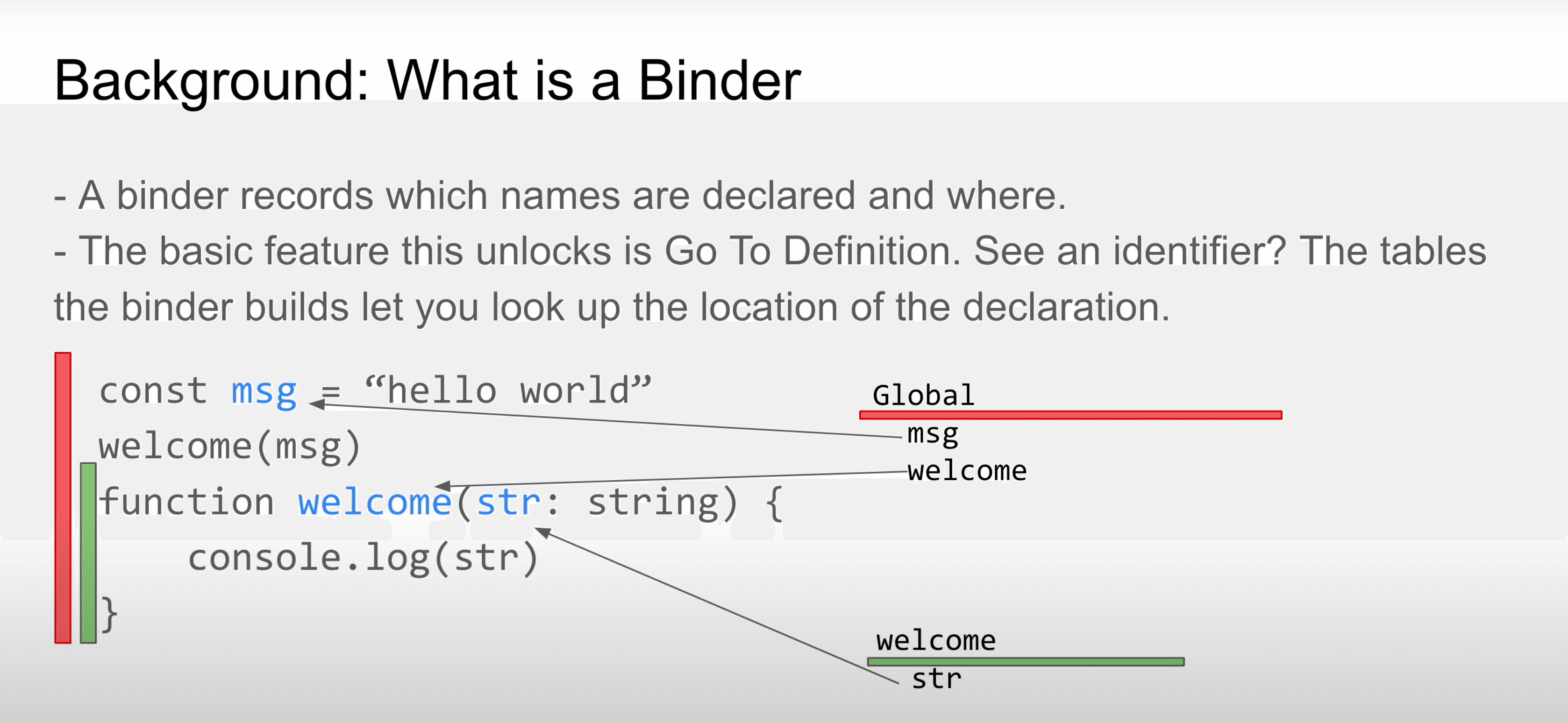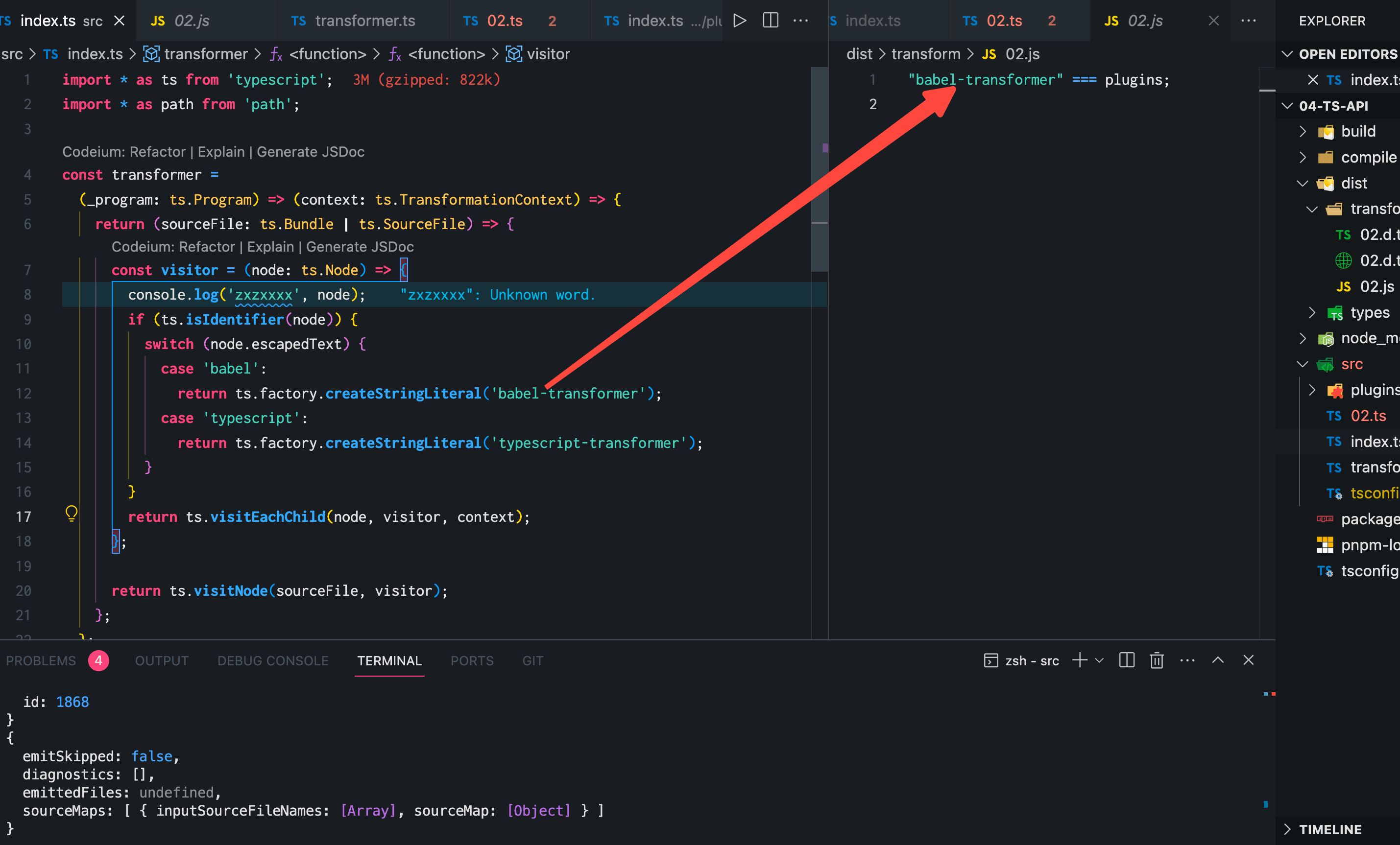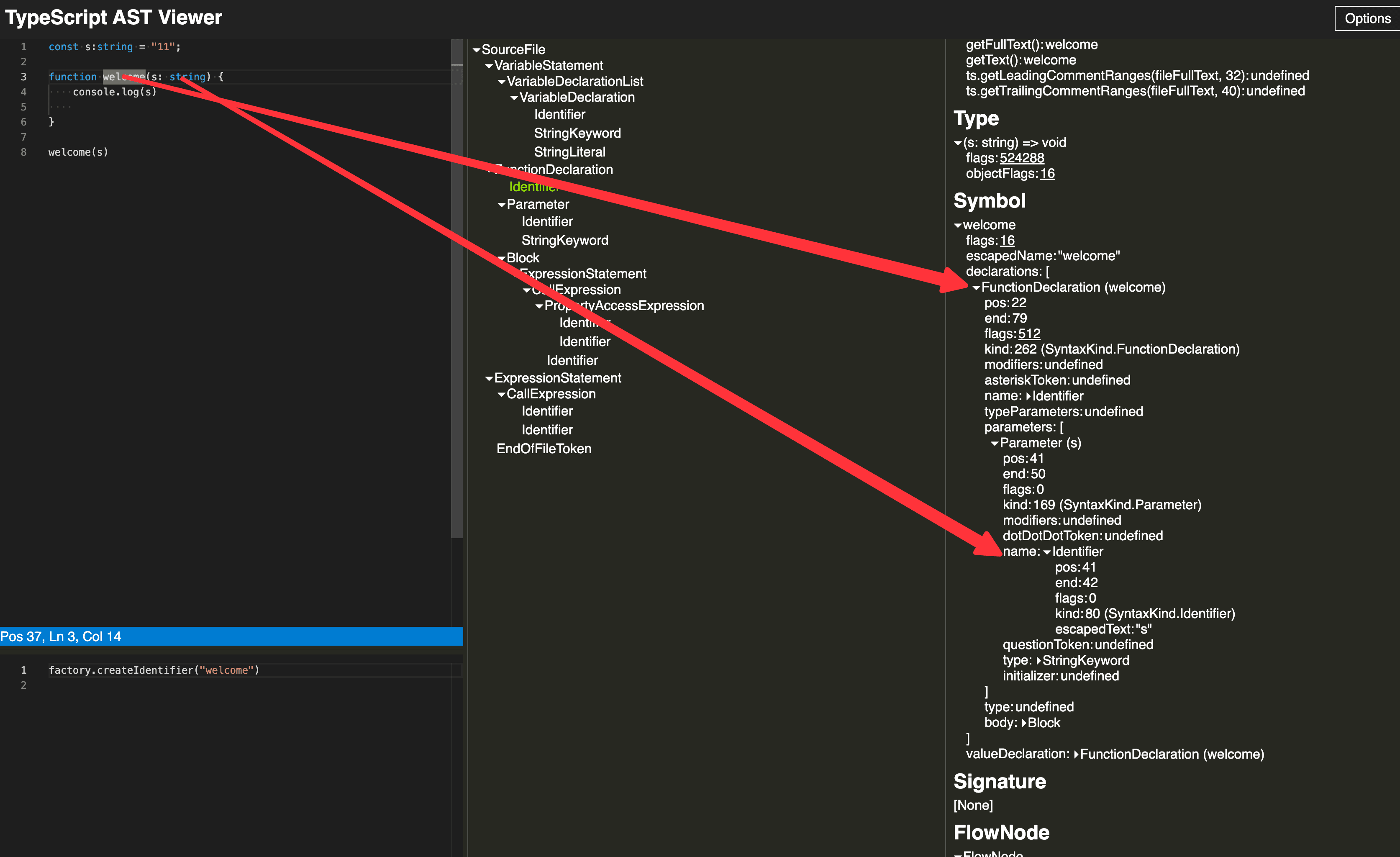背景#
之前在进行 SDK 编译流程的时候,为了方便开发者开发,经常会写一些 alias 方便将一些长的相对路径变成一个个很短的 alias 之后的路径。
例如
{
// ...
"baseUrl":"src",
"paths": {
"@/package": ["./index"],
"@/package/*": ["./*"],
}
}
这样的作用是将别名永远指向 src 目录,当 src 目录下面层级非常深的文件引用顶层的文件的时候,可以直接写成,这样可以减少相对路径的引用,让代码看着美观 && 方便调整文件的目录结构。
import Components from "@/package/ui/header"
这样的话开发阶段的话,DX 体验友好,但是当我们最终把代码打包成 SDK 的时候,使用 SDK 的宿主环境不一定和我们配置成一样的 alias,不一致的话就会存在找不到文件的问题,这就需要我们在打包 TS 的的时候将 alias 的相关文件编译会相对路径,实现所有引入方的兼容。这样就需要对于 TS 的编译流程有个了解
TS compiler 相关#
TS 的编译流程#
SourceCode(源码) ~~ 扫描器(Scanner) ~~> Token 流
Token 流 ~~ 解析器 (parser) ~~> AST(抽象语法树)
AST ~~ 绑定器 (binder) ~~> Symbols(符号)
AST + 符号(Symbols) ~~ 检查器 ~~> 类型验证
AST + 检查器 ~~ 发射器(emitter) ~~> JavaScript 代码
扫描器#
TS(TypeScript)中的 scanner(扫描器)是编译器的第一个阶段,也被称为词法分析器。它负责将源代码文件中的字符流转换成一系列的词法单元(tokens)。
工作方式如下:
- 读取字符流: scanner 从源代码文件中逐个读取字符。
- 识别词法单元: scanner 根据一组预定义的语法规则,将字符组合成识别出的词法单元,如标识符、关键字、运算符、常量等。它使用有限自动机(finite automation)或正则表达式来匹配字符序列。
- 生成词法单元:一旦识别出一个完整的词法单元,scanner 将其生成为一个包含类型和值信息的对象,并将其传递给下一个阶段的编译器。
- 处理特殊情况: scanner 同时处理特殊情况,如注释、字符串字面量,以及对转义字符的解析等。
例如,考虑以下 TypeScript 代码片段:
let age: number = 25;
scanner 将逐个读取字符并生成以下词法单元:
- let 关键字
- age 标识符
- : 冒号(运算符)
- number 关键字
- = 等号(运算符)
- 25 数字常量
- ; 分号(分隔符)
词法单元生成的顺序由语法规则定义,scanner 会不断重复这个过程,直到源代码文件中的所有字符都被处理完毕。 这个阶段只是将相关的 token 提取出来,没有进行语法,语义相关的分析。
import * as ts from "typescript";
// TypeScript has a singleton scanner
const scanner = ts.createScanner(ts.ScriptTarget.Latest, /*skipTrivia*/ true);
// That is initialized using a function `initializeState` similar to
function initializeState(text: string) {
scanner.setText(text);
scanner.setOnError((message: ts.DiagnosticMessage, length: number) => {
console.error(message);
});
scanner.setScriptTarget(ts.ScriptTarget.ES5);
scanner.setLanguageVariant(ts.LanguageVariant.Standard);
}
// Sample usage
initializeState(`
var foo = 123;
`.trim());
// Start the scanning
var token = scanner.scan();
while (token != ts.SyntaxKind.EndOfFileToken) {
console.log(ts.SyntaxKind[token]);
token = scanner.scan();
}
output
VarKeyword
Identifier
FirstAssignment
FirstLiteralToken
SemicolonToken
解析器#
TS(TypeScript)的解析器是用于将 TypeScript 代码转换为抽象语法树(Abstract Syntax Tree,简称 AST)的工具。解析器的主要作用是将源代码解析为语法树,以便后续的静态分析、类型检查和编译等操作。
解析器通过分析源代码的词法(Lexical)和语法(Syntactic)结构来构建语法树。词法分析阶段将源代码分解为标记(Tokens),例如关键字、标识符、运算符和常量等。语法分析阶段将标记组织成一个树形结构,确保代码的语法正确性。
import * as ts from "typescript";
function printAllChildren(node: ts.Node, depth = 0) {
console.log(new Array(depth + 1).join('----'), ts.SyntaxKind[node.kind], node.pos, node.end);
depth++;
node.getChildren().forEach(c=> printAllChildren(c, depth));
}
var sourceCode = `
var foo = 123;
`.trim();
var sourceFile = ts.createSourceFile('foo.ts', sourceCode, ts.ScriptTarget.ES5, true);
printAllChildren(sourceFile);
output
SourceFile 0 14
---- SyntaxList 0 14
-------- VariableStatement 0 14
------------ VariableDeclarationList 0 13
---------------- VarKeyword 0 3
---------------- SyntaxList 3 13
-------------------- VariableDeclaration 3 13
------------------------ Identifier 3 7
------------------------ FirstAssignment 7 9
------------------------ FirstLiteralToken 9 13
------------ SemicolonToken 13 14
---- EndOfFileToken 14 14
绑定器#
一般的 JavaScript 解析器的流程大致是
SourceCode ~~Scanner~~> Tokens ~~Parser~~> AST ~~Emitter~~> JavaScript
但是上面的流程对于 TS 来说少了一个关键的步骤 TypeScript 的语义** 系统,** 为了协助(检查器执行)类型检查,绑定器将源码的各部分连接成一个相关的类型系统,供检查器使用。绑定器的主要职责是创建_符号_(Symbols)
- 简单理解

- 深入探索结构
 #
#
可以通过里面的 pos end 来判断作用域相关的引用唯一性
检查器#
这里会联合上面 binder 产生出来的 Symbol 一起做类型推导,类型检查等
代码示例
import * as ts from "typescript";
import path from 'path'
// 创建一个 TypeScript 项目
const program = ts.createProgram({
rootNames: [path.join(__dirname, './check.ts')], // 项目中所有要检查的文件的路径
options: {
...ts.getDefaultCompilerOptions(),
baseUrl: '.'
}, // 编译选项
});
// 获取项目中的所有语义错误
const diagnostics = ts.getPreEmitDiagnostics(program)
// 打印错误信息
diagnostics.forEach((diagnostic) => {
console.log(
`Error: ${ts.flattenDiagnosticMessageText(diagnostic.messageText, "\n")}`
);
});
check.ts
const a:string = 1
console.log(a)
const b = ({)
output
Error: Type 'number' is not assignable to type 'string'.
Error: Property assignment expected.
Error: '}' expected.
发射器#
- emitter.ts:是 TS -> JavaScript 的发射器
- declarationEmitter.ts:这个发射器用于为 TypeScript 源文件(.ts) 创建_声明文件_
Emit 阶段会调用 Printer 将 AST 转换为文本,Printer(打印器)这个名字非常贴切,将 AST 打印成文本
import * as ts from 'typescript';
const printer = ts.createPrinter();
const result = printer.printNode(
ts.EmitHint.Unspecified,
makeNode(),
undefined,
);
console.log(result);
function makeNode() {
return ts.factory.createVariableStatement(
undefined,
ts.factory.createVariableDeclarationList(
[
ts.factory.createVariableDeclaration(
ts.factory.createIdentifier('video'),
undefined,
ts.factory.createKeywordTypeNode(ts.SyntaxKind.NumberKeyword),
ts.factory.createStringLiteral('conference'),
),
],
ts.NodeFlags.Const,
),
);
}
Transformers#
上面的部分介绍了 TS 编译代码的一些流程,同时 TS 也给我们提供了一些类似于 “生命周期的钩子”,允许我们在编译的流程中添加自己自定义的部分。
- before 在 TypeScript 之前运行转换器 (代码还没有编译)
- after 在 TypeScript 之后运行转换器 (代码已编译)
- afterDeclarations 在声明步骤之后运行转换器 (你可以在这里转换类型定义)
API#
visiting#
- ts.visitNode (node, visitor) 用来遍历 root node
- ts.visitEachChild (node, visitor, context) 用来遍历子节点
- ts.isXyz (node) 用来判断节点类型的 例如 ts.isVariableDeclaration (node)
Nodes#
- ts.createXyz 创建新节点 (然后返回),ts.createIdentifier ('world')
- ts.updateXyz 用来更新节点 ts.updateVariableDeclaration ()
书写一个 transformer#
const transformer =
(_program: ts.Program) => (context: ts.TransformationContext) => {
return (sourceFile: ts.Bundle | ts.SourceFile) => {
const visitor = (node: ts.Node) => {
console.log('zxzxxxx', node);
if (ts.isIdentifier(node)) {
switch (node.escapedText) {
case 'babel':
return ts.factory.createStringLiteral('babel-transformer');
case 'typescript':
return ts.factory.createStringLiteral('typescript-transformer');
}
}
return ts.visitEachChild(node, visitor, context);
};
return ts.visitNode(sourceFile, visitor);
};
};
const program = ts.createProgram([path.join(__dirname, './02.ts')], {
baseUrl: '.',
target: ts.ScriptTarget.ESNext,
module: ts.ModuleKind.ESNext,
declaration: true,
declarationMap: true,
jsx: ts.JsxEmit.React,
moduleResolution: ts.ModuleResolutionKind.NodeJs,
skipLibCheck: true,
allowSyntheticDefaultImports: true,
outDir: path.join(__dirname, '../dist/transform'),
});
const res = program.emit(undefined, undefined, undefined, undefined, {
after: [transformer(program)],
});
console.log(res);

更多代码示例 https://github.com/itsdouges/typescript-transformer-handbook/tree/master/example-transformers
实际具体的应用#
import path from 'path';
import { chain, head, isEmpty } from 'lodash';
import ts from 'typescript';
export function replaceAlias(
fileName: string,
importPath: string,
paths?: Record<string, string[]>
) {
if (isEmpty(paths)) return importPath;
const normalizedPaths = chain(paths)
.mapKeys((_, key) => key.replace(/\*$/, ''))
.mapValues(head)
.omitBy(isEmpty)
.mapValues((resolve) => (resolve as string).replace(/\*$/, ''))
.value();
for (const [alias, resolveTo] of Object.entries(normalizedPaths)) {
if (importPath.startsWith(alias)) {
const resolvedPath = importPath.replace(alias, resolveTo);
const relativePath = path.relative(path.dirname(fileName), resolvedPath);
return relativePath.startsWith('.') ? relativePath : `./${relativePath}`;
}
}
return importPath;
}
export default function (_program?: ts.Program | null, _pluginOptions = {}) {
return ((ctx) => {
const { factory } = ctx;
const compilerOptions = ctx.getCompilerOptions();
return (sourceFile: ts.Bundle | ts.SourceFile) => {
const { fileName } = sourceFile.getSourceFile();
function traverseVisitor(node: ts.Node): ts.Node | null {
let importValue: string | null = null;
if (ts.isCallExpression(node)) {
const { expression } = node;
if (node.arguments.length === 0) return null;
const arg = node.arguments[0];
if (!ts.isStringLiteral(arg)) return null;
if (
// Can't call getText on after step
expression.getText(sourceFile as ts.SourceFile) !== 'require' &&
expression.kind !== ts.SyntaxKind.ImportKeyword
)
return null;
importValue = arg.text;
// import, export
} else if (
ts.isImportDeclaration(node) ||
ts.isExportDeclaration(node)
) {
if (
!node.moduleSpecifier ||
!ts.isStringLiteral(node.moduleSpecifier)
)
return null;
importValue = node.moduleSpecifier.text;
} else if (
ts.isImportTypeNode(node) &&
ts.isLiteralTypeNode(node.argument) &&
ts.isStringLiteral(node.argument.literal)
) {
importValue = node.argument.literal.text;
} else if (ts.isModuleDeclaration(node)) {
if (!ts.isStringLiteral(node.name)) return null;
importValue = node.name.text;
} else {
return null;
}
const newImport = replaceAlias(
fileName,
importValue,
compilerOptions.paths
);
if (!newImport || newImport === importValue) return null;
const newSpec = factory.createStringLiteral(newImport);
let newNode: ts.Node | null = null;
if (ts.isImportTypeNode(node))
newNode = factory.updateImportTypeNode(
node,
factory.createLiteralTypeNode(newSpec),
node.assertions,
node.qualifier,
node.typeArguments,
node.isTypeOf
);
if (ts.isImportDeclaration(node))
newNode = factory.updateImportDeclaration(
node,
node.modifiers,
node.importClause,
newSpec,
node.assertClause
);
if (ts.isExportDeclaration(node))
newNode = factory.updateExportDeclaration(
node,
node.modifiers,
node.isTypeOnly,
node.exportClause,
newSpec,
node.assertClause
);
if (ts.isCallExpression(node))
newNode = factory.updateCallExpression(
node,
node.expression,
node.typeArguments,
[newSpec]
);
if (ts.isModuleDeclaration(node))
newNode = factory.updateModuleDeclaration(
node,
node.modifiers,
newSpec,
node.body
);
return newNode;
}
function visitor(node: ts.Node): ts.Node {
return traverseVisitor(node) || ts.visitEachChild(node, visitor, ctx);
}
return ts.visitNode(sourceFile, visitor);
};
}) as ts.TransformerFactory<ts.Bundle | ts.SourceFile>;
}
参考资料#
https://www.youtube.com/watch?v=BU0pzqyF0nw
https://github.com/basarat/typescript-book
https://github.com/itsdouges/typescript-transformer-handbook
https://github.com/LeDDGroup/typescript-transform-paths
https://github.com/nonara/ts-patch
https://github.com/LeDDGroup/typescript-transform-paths/blob/v1.0.0/src/index.ts
https://github.com/microsoft/TypeScript-Compiler-Notes
